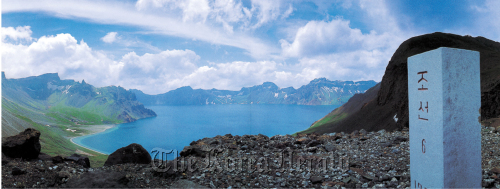Located on the border between North Korea and China, Mt. Baekdu is the highest mountain on the Korean Peninsula.
A dormant volcano, the mountain has been considered sacred ever since the legendary first Kingdom of Korea, Gojoseon (2233 B.C.-108 BC).
After the Korean War (1950-1953), not many academic accounts of the mountain were published by South Korean scholars. Back in June, however, the mountain managed to grab international attention when Yoon Seong-hyo, a scholar from Busan National University, said it will see a major volcanic eruption in four to five years. Last month, the National Emergency Management Agency reported that any eruption of the volcano would likely cause severe flood damage in North Korea, destroying roads and buildings within a 30 kilometer-radius in just 3 hours and 20 minutes.
A dormant volcano, the mountain has been considered sacred ever since the legendary first Kingdom of Korea, Gojoseon (2233 B.C.-108 BC).
After the Korean War (1950-1953), not many academic accounts of the mountain were published by South Korean scholars. Back in June, however, the mountain managed to grab international attention when Yoon Seong-hyo, a scholar from Busan National University, said it will see a major volcanic eruption in four to five years. Last month, the National Emergency Management Agency reported that any eruption of the volcano would likely cause severe flood damage in North Korea, destroying roads and buildings within a 30 kilometer-radius in just 3 hours and 20 minutes.

Amid the current controversy, the Academy of Korean Studies published a rare academic account of the mountain, “Mt. Baekdu: Present and Future” this week. With contributions from 13 scholars, the book extensively discusses the mountain in four categories: its history, environment, ecology and cultural merits.
For the last 10 years, the Academy of Korean Studies has been interacting with North Korea’s Academy of Social Sciences, the communist nation’s official academic-research institute. Mostly at Yanbian University in Jilin Province, China, scholars from the two Koreas would gather for academic conferences on diverse issues concerning the peninsula.
Yun Ji-seon, the editor of the book, said “Mt. Baekdu: Present and Future” had been initially planned to be co-written by the scholars from both Koreas. “It did not work out because the North Korean staff insisted their late leader Kim Il-sung’s propagated myth that he organized his resistance against the Japanese occupation at the mountain be in the introduction,” she said.
Though it is not co-written, many parts of the book have been written based on the research material North Korean scholars provided through Yanbian University.
“The South Korean scholars have verified the materials along with Chinese scholars, and made sure they are factual,” Yun said.
Along with analysis on the mountain’s history and ecology, the book also offers an extensive discussion on the current border dispute at the mountain between North Korea and China. It particularly addresses China’s recent claim that Duman (Tumen) River, a long river that serves as part of the boundary between China and North Korea, originates from Wonji, a lake located in Mt. Baekdu in Chinese territory.
Previously, it had been widely believed that the river flows from Cheonji of Mt. Baekdu, a crater lake on the border between China and North Korea. “Because Wonji is Chinese property, if the Duman River which sets the boundary between the two countries originates from there, it’s easier for the Chinese to claim more parts of the mountain as their territory,” said Yun. “The river and the border between the two countries become a lot shorter if it flows from Wonji, which is located far east of Cheonji.”
Kim Jeong-bae, the president of the Academy of Korean Studies and one of the authors of the book said the team started the project because they hadn’t seen many texts on the mountain despite its cultural, historical, and environmental significance.
“We live in a reality where more research on the mountain can make a lot of difference,” he said, “especially because there are a lot of historical debates between Korea and China, on the territorial matters of the mountain.”
By Claire Lee (clairelee@heraldcorp.com)



![[Exclusive] Korean military set to ban iPhones over 'security' concerns](http://res.heraldm.com/phpwas/restmb_idxmake.php?idx=644&simg=/content/image/2024/04/23/20240423050599_0.jpg&u=20240423183955)
![[AtoZ into Korean mind] Humor in Korea: Navigating the line between what's funny and not](http://res.heraldm.com/phpwas/restmb_idxmake.php?idx=644&simg=/content/image/2024/04/22/20240422050642_0.jpg&u=)




![[Graphic News] 77% of young Koreans still financially dependent](http://res.heraldm.com/phpwas/restmb_idxmake.php?idx=644&simg=/content/image/2024/04/22/20240422050762_0.gif&u=)
![[Herald Interview] Why Toss invited hackers to penetrate its system](http://res.heraldm.com/phpwas/restmb_idxmake.php?idx=644&simg=/content/image/2024/04/22/20240422050569_0.jpg&u=20240422150649)




![[Exclusive] Korean military to ban iPhones over security issues](http://res.heraldm.com/phpwas/restmb_idxmake.php?idx=652&simg=/content/image/2024/04/23/20240423050599_0.jpg&u=20240423183955)



![[Today’s K-pop] Ateez confirms US tour details](http://res.heraldm.com/phpwas/restmb_idxmake.php?idx=642&simg=/content/image/2024/04/23/20240423050700_0.jpg&u=)